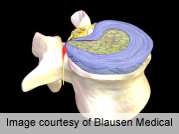For patients undergoing surgery for lumbar herniated intervertebral disc disease, reoperation rates reach 13.4 percent after five years, with more than half of reoperations occurring in the first year, according to a study published in the April 1 issue of Spine.
(HealthDay)—For patients undergoing surgery for lumbar herniated intervertebral disc disease, reoperation rates reach 13.4 percent after five years, with more than half of reoperations occurring in the first year, according to a study published in the April 1 issue of Spine.
Chi Heon Kim, M.D., Ph.D., from Seoul National University Hospital in the Republic of Korea, and colleagues conducted a retrospective cohort study using data from 18,590 patients identified from a national health insurance database to examine the longitudinal reoperation rate after surgery for lumbar herniated intervertebral disc disease. Patients were followed for at least five years.
The researchers found that the most common procedure was open discectomy (68.9 percent), followed by endoscopic discectomy, laminectomy, fusion, and nucleolysis (16.1, 7.9, 3.9, and 3.1 percent, respectively). At three months, the cumulative reoperation rate was 5.4 percent, and at one, two, three, four, and five years, it was 7.4, 9.0, 10.5, 12.1, and 13.4 percent, respectively. The reoperation rate was 18.6 percent after laminectomy, 14.7 percent after nucleolysis, 13.8 percent after open discectomy, 12.4 percent after endoscopic discectomy, and 11.8 percent after fusion. At three months, the reoperation rates of all procedures except laminectomy were not significantly different to that of open discectomy.
"Here, for herniated intervertebral disc disease-related surgery, the cumulative reoperation rate during five years of follow-up was 13.4 percent with half of the reoperations occurring during the first postoperative year," the authors write. "Although our population-based data lacked detailed information, the results obtained may be useful to clinicians and patients."
More information:
Abstract
Full Text (subscription or payment may be required)
Journal information: Spine
Health News Copyright © 2013 HealthDay. All rights reserved.























